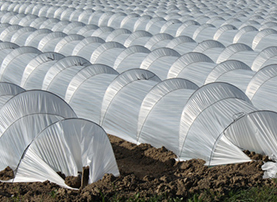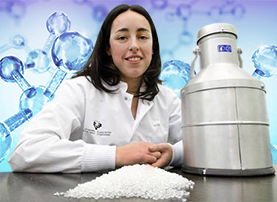

Polaquimia® le ofrece una amplia variedad de soluciones químicas multifuncionales con importantes ventajas competitivas en procesos industriales, energéticos, productivos o en la fabricación de materias primas.
Polaquimia® offers a wide range of multifunctional chemical solutions with significant competitive advantages in industrial, energy, processes and in the manufacture of raw materials.



Maíz de 10
En noviembre de 2016 se cumplieron 10 años de la primera cosecha de maíz bajo el modelo de agricultura sostenible en las instalaciones del Centro de Desarrollo Tecnológico Villadiego de FIRA (Fideicomisos instituidos en relación con la Agricultura), en Valle de Santiago, Guanajuato.
Este modelo está basado en cuatro componentes fundamentales: 1) Sistema de labranza de conservación (L-C), 2) Manejo integrado de plagas, enfermedades y malezas, 3) Nutrición balanceada y 4) Uso racional del agua vía tecnificación del riego a través de un sistema de riego por goteo subsuperficial.

Plásticos biodegradables a partir de una enzima bacteriana
Se ha conseguido determinar la estructura de una enzima bacteriana que puede producir plásticos biodegradables, un avance que podría ayudar a los ingenieros químicos a modificarla para que sea aún más útil industrialmente. El logro es obra del equipo de las investigadoras Elizabeth Wittenborn, Catherine Drennan y JoAnne Stubbe, del Instituto Tecnológico de Massachusetts (MIT).
La enzima genera largas cadenas poliméricas que pueden formar plásticos duros o blandos, dependiendo de los materiales de partida que se introduzcan en el proceso.

Ecocompuestos, una solución para los residuos plásticos de la agricultura
El grupo de investigación Polímeros, Caracterización y Aplicaciones de la Universidad Politécnica de Madrid, en colaboración con el Laboratorio de Ingeniería de Polímeros del Departamento de Ingeniería Química y Tecnología del Medio Ambiente de la Universidad de Oviedo, en España, han llevado a cabo una investigación que permite recuperar desechos plásticos de agricultura y convertirlos en nuevos materiales de mayor valor añadido, bajo precio y reciclabilidad mejorada. Con ellos, se reduciría el impacto ambiental que genera este tipo de residuos agrícolas.
La utilización de plásticos en agricultura, tanto en película de invernadero como en túnel y acolchado, ha crecido considerablemente desde los años cincuenta, debido al aumento de la población mundial y a la mayor necesidad de producir alimentos.

Hidrógeno a partir de residuos plásticos
Se dice que el hidrógeno es el combustible del futuro, y por eso, se estudian en el mundo todo tipo de procesos para su obtención. Itsaso Barbarias, investigadora del Departamento de Ingeniería Química de la Facultad de Ciencias y Tecnología de la Universidad del País Vasco, ha investigado en su tesis doctoral un proceso para obtener hidrógeno a partir de residuos plásticos.
En la investigación, han utilizado un proceso de dos etapas para obtener hidrógeno de plásticos. En la primera etapa, se somete a los plásticos a pirólisis (degradación térmica de plásticos sin oxígeno) en un reactor cónico de lecho en surtidor, en el que suceden grandes transferencias de calor y masa debido a los movimientos cíclicos que surgen en este. Los gases así obtenidos pasan a la siguiente etapa en continuo. En esta segunda etapa, se utiliza el reformado catalítico con vapor: los gases de la primera etapa reaccionan con vapor, en presencia de un catalizador, para obtener hidrógeno.

Maize of 10
In November 2016, ten years of the first maize crop under the sustainable agriculture model were celebrated at the facilities of the Technological Development Center of Villadiego from FIRA (Trust instituted in relation to Agriculture in Valle de Santiago, Guanajuato).
This model is based on four fundamental components: 1) Conservation tillage system, 2) Integrated management of pests, diseases and weeds, 3) Balanced nutrition and 4) Rational use of water via irrigation technology through a subsurface drip irrigation system.

Biodegradable plastics from a bacterial enzyme
It has been possible to determine the structure of a microbial enzyme that can produce biodegradable plastics, a breakthrough that could help chemical engineers to modify it to be even more useful industrially.
The achievement is the work of the team of researchers Elizabeth Witterborn, Catherine Drennan and JoAnne Stubb, Massachusetts Institute of Technology (MIT).
The enzyme generates long polymer chains that can form hard or soft plastics, depending on the starting materials that are introduced in the process.

Biocomposites, a solution for plastic waste from agriculture.
The research group Polymers, Characterization and Applications of the Polytechnic University of Madrid, in collaboration with the Laboratory of Polymer Engineering of the Department of Chemical Engineering and Environmental Technology of the University of Oviedo, Spain, carried out a research Which allows the recovery of plastic waste from agriculture and convert it into new materials of higher added value, low price and improved recyclability. With them, the environmental impact generated by this type of agricultural waste would be reduced.
The use of plastics in agriculture, both in greenhouse film and in tunnel and padding, has grown considerably since the 1950s, due to the increase in world population and the increased need to produce food.

Hydrogen from plastic waste
It is said that hydrogen is the fuel of the future, and that is why, all kinds of processes are studied in the world for its production. Itsaso Barbarias, researcher of the Department of Chemical Engineering of the Faculty of Sciences and Technology of the University of the Basque Country, has investigated in her doctoral thesis a process to obtain hydrogen from plastic waste.
In the research, they have used a two-stage process to obtain hydrogen from plastics. In the first stage, the plastics are subjected to pyrolysis (thermal degradation of plastics without oxygen) in a conical jet bed reactor, where large heat and mass transfers occur due to the cyclic movements that arise in it. The gases thus obtained pass to the next step continuously. In this second stage, catalytic reforming is used with steam: the first stage gases react with steam, in the presence of a catalyst, to obtain hydrogen.